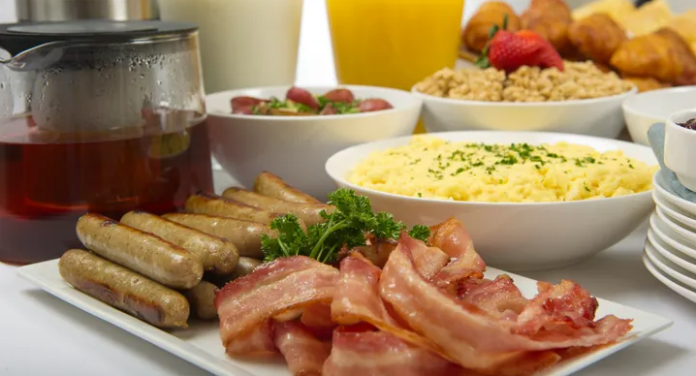When you’re on vacation, one of the perks of staying at a hotel is the free continental breakfast or breakfast buffet included with your visit. However, one of the biggest setbacks you can have on a vacation is being relegated to the bathroom after contracting a foodborne illness.
Food that’s been sitting out all morning can be at high risk of potential bacteria contamination, so it’s important to know which items are safe to eat and which ones you may want to skip.
According to Dr. Ellen Shumaker, director of outreach for the Safe Plates Program at North Carolina State University, two main factors can increase the risk of getting a foodborne illness.
[ The Unexpected Effect Coffee Can Have On Your Period ]
The first is the temperature control of foods, and the second is other guests potentially contaminating utensils or food due to a lack of handwashing.
Unfortunately, you can’t always taste the difference when food is contaminated, so it’s crucial to know what to look out for ahead of time.
Certain microorganisms can contaminate food, prove to be pathogenic or produce toxins. For example, certain E. coli, salmonella, or listeria species only require a few cells to cause havoc.
What to Avoid
When it comes to a hotel breakfast buffet, there are certain items that food safety experts usually avoid. One of the key factors to consider is temperature control. Hot foods should be kept hot, and cold foods should be kept cold to prevent the temperature danger zone where bacteria thrive.
If you see sausage patties, bacon, scrambled eggs, quiches, or other meat and egg products sitting out without any heating appliance, it’s best to skip those.
These types of foods should be kept warm with a device such as a hot plate or chafing dish. While this doesn’t give the exact temperature, it is an indicator that measures are being taken to keep the food in a safe temperature range.
Milk that’s been sitting around without refrigeration or being kept on ice should also be avoided.
Perishable items like yoghurt, cheeses, deli meats, and precut fruits and veggies (such as tomatoes, leafy greens, and melon) should be chilled. When these items are cut, the fleshy part has moisture and pH levels that allow bacteria to grow.
Both fresh and pasteurized juices should be cold. Fresh juice, in particular, is at a higher risk for growing harmful bacteria when left out at room temperature. On the other hand, shelf-stable juices packaged in boxes, bottles, or cans don’t need to be refrigerated.
Individually wrapped creamers and butter packets don’t need to be kept cold either. These types of creamers have been treated to kill off bacteria, and the salt in the butter helps it maintain shelf stability.
Catch up with the latest news from The Times Post on WhatsApp by following our channel. Click here to join.
Kindly follow @thetimespost on Instagram. On X (Twitter), follow @thetimespost2.















